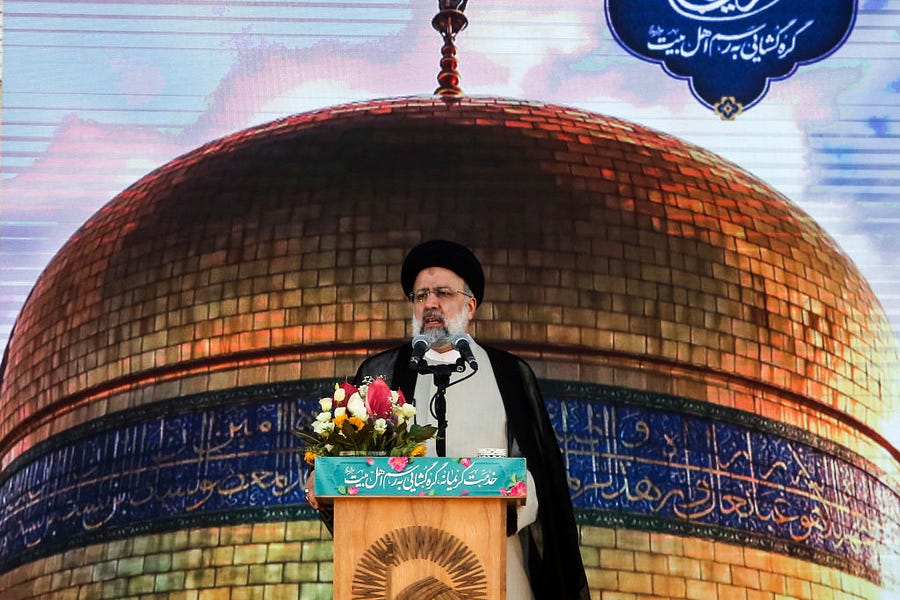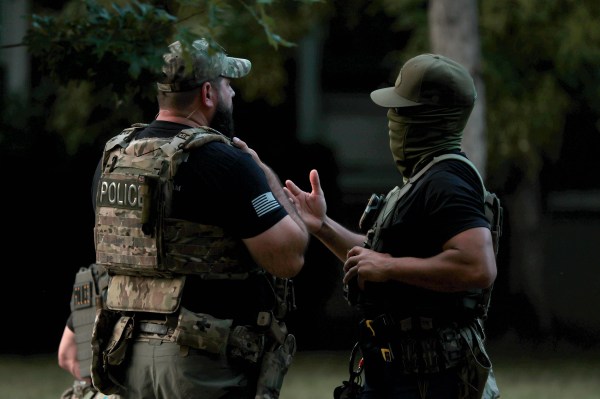The Guardian’s diplomatic editor put it best. “If Joe Biden thinks Vladimir Putin deserves to be called a killer, his description of Ebrahim Raisi, the 60-year-old president-elect of Iran, is likely to be unprintable.”
The selection of Raisi—an ultra-hardline cleric responsible for the mass execution of dissidents—provides a timely reminder as to the nature of the regime in Tehran, the threat it represents, and the continued requirement for forward-positioned U.S. forces in the Middle East.
Raisi’s revolutionary resume stands out due to his participation in a four-person “death commission” that oversaw the execution of an estimated 5,000 political prisoners in the late 1980s. And the passage of time has apparently not encouraged any contrition from Raisi. During his first post-election press conference on Monday, Raisi was asked about his role in the mass murders. “I have always defended people’s rights,” he responded. “Human rights have been a pivotal point for me.”
That retort likely pleased Supreme Leader Ayatollah Ali Khamenei. As Iran’s “most important voter,” Khamenei sees elections as a way to squeeze the already narrow political spectrum in the country. A reported 592 candidates registered for the election, but only seven were approved to run by the Guardian Council, which vets candidates for public office and is loyal to Khamenei. Given his age, 82, Khamenei was eager to use the election to cement the hardline domination of Iran’s institutions and keep the country on its revolutionary trajectory even after his death.
Don’t forget missiles and terrorism.
Raisi also used Monday’s press conference to make clear he was on the same page as Khamenei regarding the regime’s foreign policy. Reflecting the support Raisi enjoys from the Islamic Revolutionary Guard Corps, he reiterated that Iran’s ballistic missile program and support for regional proxy (terrorist) groups are “not negotiable.”
Raisi’s comments are noteworthy not because they represent an independent viewpoint. They are significant because they clearly signal stasis in Iranian policy, which is ultimately determined by Iran’s supreme leader.
The Biden team appears to understand that the buck stops with Khamenei, and yet the administration unfortunately remains determined to re-enter the flawed 2015 Iran nuclear deal. Astute analysts have long understood that the deal provides Iran a patient pathway to nuclear weapons capability. Raisi’s comments, however, should serve as a reminder that the agreement also lowered international pressure on Iran’s ballistic missile program and Tehran’s procurement and proliferation of arms. In fact, the agreement provided Tehran even more resources to support both efforts.
In full damage control mode on Monday, State Department spokesman Ned Price argued that issues related to missiles and terrorism would be addressed in “follow-on diplomacy.” But any Biden administration belief that it can, after re-entering the Iran deal, elicit subsequent and serious concessions from Tehran on missiles and terrorism is naïve at best. In reality, once Tehran locks in the United States to the agreement again and achieves sanctions relief, the regime will have even less incentive to negotiate in good faith regarding its missile arsenal or its support for terrorist groups.
That is a serious problem for the United States, Israel, and Iran’s Arab neighbors.
The Islamic Republic, after all, already possesses the largest ballistic missile arsenal in the Middle East and has been working to improve the accuracy, lethality, and range of its missiles.
And that growing arsenal is not simply for show. Tehran has demonstrated an increased willingness to use its ballistic and cruise missiles (as well as drones) to conduct attacks, while proliferating some of those capabilities to its terrorist proxies throughout the region.
In January 2020, Iran fired more than a dozen ballistic missiles at two bases in Iraq housing U.S. troops in retaliation for the killing of Qassem Suleimani. Let there be no doubt—Tehran was trying to kill Americans. The Pentagon had no ballistic missile interceptors in range, leaving the American service members vulnerable and scrambling for cover. While more than 100 American troops tragically suffered traumatic brain injuries, no Americans died thanks to early warning provided by U.S. satellites.
Iran has also shared missiles and other arms with its proxies.
U.S. naval interdictions in November 2019 and February 2020 uncovered Iranian weapons shipments headed to Yemen that contained land-attack cruise missiles, surface-to-air missiles, and anti-ship cruise missiles. Iran-backed Houthi rebels have used these types of capabilities to launch an attack on a U.S. Navy destroyer in the Red Sea, as well as hundreds of strikes targeting civilians in Saudi Arabia.
Iran’s proliferation efforts have also included a concerted campaign to help Hezbollah—Tehran’s terror proxy in Lebanon—field thousands of precision guided munitions to target Israel. Israel views this growing PGM arsenal in Lebanon as an increasingly grave threat, second only to Iran’s pursuit of a nuclear weapon capability. Indeed, the two threats are connected. Tehran almost certainly views Hezbollah’s arsenal in Lebanon as a means to deter or punish any effort by Israel to conduct a major attack on the Islamic Republic’s nuclear program.
It would be a mistake to assume Hezbollah will never use this arsenal against Israel. After all, Tehran played a vital role in arming and equipping Hamas and Palestinian Islamic Jihad (PIJ) in Gaza with rockets and domestic production capabilities. Last month, Iranian proxies in Gaza employed these weapons, launching roughly 4,300 rockets in an attempt to murder Israeli civilians.
Hezbollah has attacked Israel before, too, and will likely do so again. When Hezbollah does so, it may employ, thanks to Tehran, a larger and more advanced arsenal than Hamas and PIJ possesses. That will enable Hezbollah to more effectively counter Israel’s missile defenses, while hitting targets more precisely and inflicting more civilian casualties.
Unfortunately, the Islamic Republic’s weapons proliferation extends to Iraq too. Given Raisi’s comments on militias, one can expect Iranian policy to change little in Iraq, where the preeminent goal is to drive the Americans out and co-opt the Iraqi state through its diverse militia network backstopped by the Islamic Revolutionary Guard Corps’ Quds Force (IRGC-QF) and its various fronts.
Iranian efforts in Iraq, after all, resulted in the deaths of more than 600 U.S. service members during the Iraq War. And the attacks by Iran and its proxies continue against Americans in Iraq. Between May 2019 and February of this year, Iran-backed militias were believed to be behind at least 83 distinct rocket attacks against positions affiliated with U.S. forces. There have been at least 10 more strikes since then, amounting to a total of more than 90 rocket attacks in two years.
Some might respond by shrugging and saying the U.S. should simply withdraw the modest military contingent that remains in Iraq (roughly 2,500 U.S. service members there now, compared with 170,000 in 2007). Yet, the continued presence of U.S. forces in Iraq (and Syria) helps prevent the return of the ISIS caliphate and helps Iraq push back on Iranian efforts to create a Hezbollah-style veto over Baghdad’s policies.
What’s next?
The Biden administration is currently conducting a U.S. military global force posture review, which will determine future U.S. military posture in the Middle East and elsewhere.
Some are eager to shift U.S. forces out of the Middle East to focus more on the threat from China. It is certainly vital to strengthen U.S. military posture in the Indo-Pacific. But slashing necessary U.S. military presence in the Middle East in the service of that objective ignores China’s increasing security role in the Middle East. That includes Beijing’s recent strategic deal with Iran, its growing arms sales in the Persian Gulf, and its first overseas military base in Djibouti—across the water from Yemen and overlooking the southern entrance to the Red Sea.
Indeed, the great power competition with China is a global one—and that includes the Middle East.
Plus, if Washington wants to focus on China, the U.S. should not pursue unconditional, timeline-based withdrawals of the U.S. troops serving in Afghanistan, Iraq, and Syria. Such withdrawals will increase the chances of an ISIS resurgence or another 9/11-style attack on the U.S. homeland.
That, more than the cost of current U.S. military posture in the Middle East, would siphon finite Pentagon resources away from necessary investments in the Indo-Pacific. And what kind of investment in the Middle East is required to protect vital American interests? On January 20, 2021, the U.S. had roughly 6,000 troops in Afghanistan, Iraq, and Syria combined. That is hardly an unsustainable troop commitment. There were four times that number of service members on Capitol Hill after January 6.
And American bases in and near the Persian Gulf help protect one of the world’s most vital commercial waterways, enable efforts to build partner capacity (thereby reducing our security burden), and provide power projection platforms needed to keep pressure on Islamist terrorist groups.
And if we ever have a serious military conflict with China, we will be glad to have military bases near the Strait of Hormuz—one of the world’s most vital energy chokepoints.
Loud and often ill-informed voices from both parties frequently respond to such arguments by bemoaning so-called “endless wars,” viewing American military withdrawals as an unambiguous and invariable good. Yet, that approach ignores former Secretary of Defense Leon Panetta’s point that withdrawals deserve as much scrutiny as decisions to launch military interventions. The “endless war” approach also ignores the dramatic reduction of U.S. forces that has already occurred in the Middle East, persistent threats there, and the fact that adversaries in the wider Middle East tend not to halt their hostile behavior following withdrawals. Instead, withdrawals often simply leave adversaries with momentum, opportunities to gather strength, and eventually a greater ability to conduct attacks.
Washington should have learned that lesson from the Obama administration’s withdrawal from Iraq in 2011—where U.S. forces were forced to return in 2014. Yet, the Biden administration is making the same mistake now in Afghanistan.
President Biden is pursuing a timeline-based withdrawal that ignores continuing threats to American interests and the advice of commanders. The fundamental flaw in the president’s thinking on Afghanistan is a dangerously inaccurate assessment of the nature and goals of the adversary, as well as their determination to continue to pursue hostile policies regardless of the American withdrawal. That determination of adversaries is independent of whether America chooses to confront the threat proactively abroad alongside brave partners or alone, later, and at greater cost on the streets of America.
Wars sometimes choose us and threats sometimes follow us home—an obvious lesson of 9/11 that apparently requires repeating.
Accordingly, as Biden implements his military withdrawal from Afghanistan, conditions there are unsurprisingly and tragically deteriorating quickly. As we saw in Iraq, don’t be surprised if American forces are forced to return to Afghanistan soon—perhaps even in a matter of months.
If the Biden administration brings a similar approach to the Islamic Republic of Iran and U.S. military posture in the Middle East more generally, don’t expect a better result. Ignoring the nature and objectives of the adversary, neglecting continued threats to core American interests in the Middle East, and failing to maintain a well-designed forward-based military posture there will simply leave Tehran increasingly unchecked as it sows terrorism around the region and targets Americans, Arabs, and Israelis.
Given the Islamic Republic of Iran’s consistent track record over the last four decades, the burden of proof clearly rests on anyone who suggests we will see a dramatic departure in the regime’s oppression of the Iranian people, instinctual hostility to America, and systematic support for terrorism.
If you doubt that argument, simply look at who the regime just picked as its president and what he said last week.
Bradley Bowman is senior director of the Center on Military and Political Power at the Foundation for Defense of Democracies, where Behnam Ben Taleblu is a senior fellow.






Please note that we at The Dispatch hold ourselves, our work, and our commenters to a higher standard than other places on the internet. We welcome comments that foster genuine debate or discussion—including comments critical of us or our work—but responses that include ad hominem attacks on fellow Dispatch members or are intended to stoke fear and anger may be moderated.
With your membership, you only have the ability to comment on The Morning Dispatch articles. Consider upgrading to join the conversation everywhere.